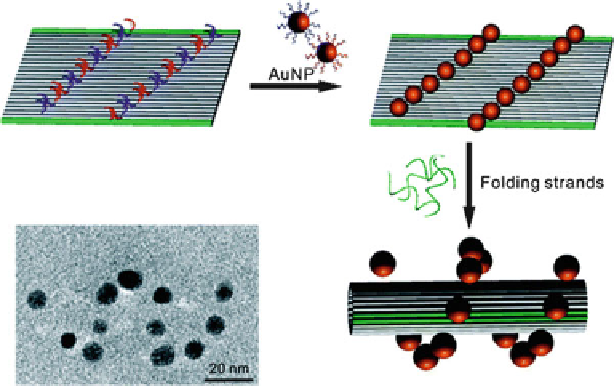Biomedical Engineering Reference
In-Depth Information
Fig. 11.16
Programmed construction of Au NP helix by folding rectangular origami. Au NPs
(10 nm) covered with corresponding DNA strands are assembled at the predesigned locations
on the origami sheet through complementary strand hybridization. The sequence of the two long
sides of the rectangular DNA origami (in
green
) is modified to be complementary to that of the
folding DNA strands. Addition of the folding strands leads to rolling and subsequent stapling of
the 2D rectangular origami sheet into a hollow DNA origami tube. As a result, the Au NPs are
automatically arranged into a 3D helix (Reprinted with permission from Ref. [
95
]. Copyright 2012
American Chemical Society)
architectures. Structural DNA nanotechnology, especially DNA origami technique,
provides an excel bottom-up approach to construct metallic nanoparticle assemblies
with well-define sizes, shapes, and spatial addressability [
92
-
94
]. Among all the
reported assays, Ding and coworkers realized a programmable way to change the
conformation of a fabricated gold nanoparticle pattern by controlling the change
of the architecture of the origami template [
95
](Fig.
11.16
). Two linear Au NP
chains are incorporated on a 2D rectangular DNA origami template at predesigned
positions. Upon the addition of folding strands that are complementary to the sticky
ends along the two long sides of the rectangular origami, the origami sheet rolls up to
form a hollow DNA origami tube, resulting in the automatic arrangement of the Au
NPs into a 3D helix. The morphologies of the origami and Au NP assembly were
monitored by AFM and TEM, respectively. The 3D Au NP helix shows a strong
chiral signal around the plasmonic resonance peak of the Au NPs.
11.4.4
Transportation and Assembly Cargos
Transportation of objects is supposed to be a basic function of a DNA nanorobot,
which could be realized easily by DNA mechanical devices. DNA walker has

Search WWH ::

Custom Search